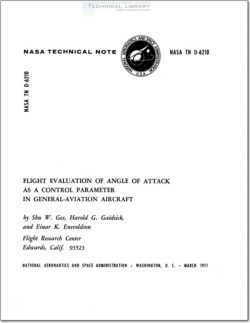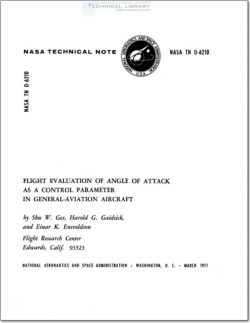NASA-TN-D-6210

- Version
- 128 Downloads
- 1.17 MB File Size
- 1 File Count
- June 15, 2016 Create Date
- June 15, 2016 Last Updated
Flight Evaluation of Angle of Attack as a Control Parameter in General Aviation Aircraft

Over the years, general—aviation airplanes have been improved so that they now
achieve performance levels comparable to those of World War II fighter aircraft. The
greater power, high wing loading. and vehicle complexity have resulted in increased
demands on the pilot‘s ability. In consideration of this problem and the continued
growth of general—aviation activity, the NASA Flight Research Center has undertaken a
program to provide the technology upon which continued improvements in safety. utility.
and economics of this class of aircraft may be based. As one part of this program. the
use of a vane—type angle —of—attack system for a pilot's display was investigated. The
results of this investigation are discussed in this report.
Numerous studies have been conducted and articles written on angle—of—attack dis—
plays for high—performance fighter. transport. and general—aviation aircraft (for
example, refs. 1 to 6), The results of these studies show that angle—of—attack infor—
mation is a usable parameter. but not necessarily a superior one. The expected
advantages of angle—of—attack information as a primary flight parameter are generally
based on two considerations: (1) angle of attack is a direct measure of stall margin
independent of aircraft weight. and (2) angle of attack responds earlier than airspeed to
the pilot's control stick and throttle inputs and to other variables which may change the
equilibrium flight condition.
For use as a piloting aid. angle of attack was displayed on a horizontal indicator
mounted above the instrument panel on the left side of the cockpit of a light. twin—engine.
general—aviation airplane. Angle—of~attack information was obtained from a sensor
mounted immediately in front of the leading edge of the left wing. Since the angle—of—
attack indicator was not considered to be a replacement for other flight instruments.
the primary question was whether this form of information. as displayed. enhanced
pilot performance and safety to justify its presence in the cockpit. Appropriate piloting
tasks. including takeoffs and climbs, low—speed maneuvering. approaches and landings.
and instrument approaches. were performed at the NASA Flight Research Center by
pilots with widely varied experience. Pilot opinion. onboard recorded data. and pre—
viously obtained full—scale wind—tunnel data for the airplane were used in the study.
| File | Action |
|---|---|
| NASA-TN-D-6210 Flight Evaluation of Angle of Attack as a Control Parameter in General Aviation Aircraft.pdf | Download |

Comment On This Post